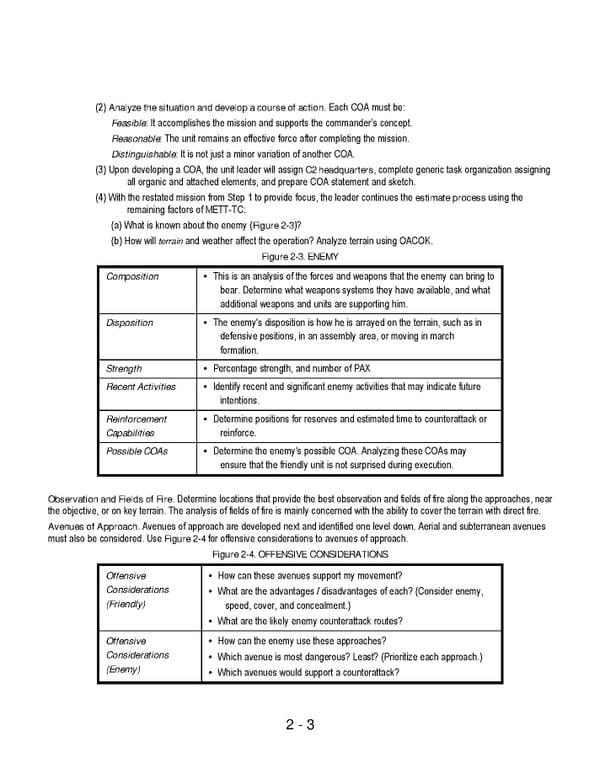2 - 3 (2) Analyze the situation and develop a course of action. Each COA must be: Feasible: It accomplishes the mission and supports the commander’s concept. Reasonable: The unit remains an effective force after completing the mission. Distinguishable: It is not just a minor variation of another COA. (3) Upon developing a COA, the unit leader will assign C2 headquarters, complete generic task organization assigning all organic and attached elements, and prepare COA statement and sketch. (4) With the restated mission from Step 1 to provide focus, the leader continues the estimate process using the remaining factors of METT-TC: (a) What is known about the enemy (Figure 2-3)? (b) How will terrain and weather affect the operation? Analyze terrain using OACOK. Figure 2-3. ENEMY Composition • This is an analysis of the forces and weapons that the enemy can bring to bear. Determine what weapons systems they have available, and what additional weapons and units are supporting him. Disposition • The enemy's disposition is how he is arrayed on the terrain, such as in defensive positions, in an assembly area, or moving in march formation. Strength • Percentage strength, and number of PAX Recent Activities • Identify recent and significant enemy activities that may indicate future intentions. Reinforcement Capabilities • Determine positions for reserves and estimated time to counterattack or reinforce. Possible COAs • Determine the enemy's possible COA. Analyzing these COAs may ensure that the friendly unit is not surprised during execution. Observation and Fields of Fire. Determine locations that provide the best observation and fields of fire along the approaches, near the objective, or on key terrain. The analysis of fields of fire is mainly concerned with the ability to cover the terrain with direct fire. Avenues of Approach. Avenues of approach are developed next and identified one level down. Aerial and subterranean avenues must also be considered. Use Figure 2-4 for offensive considerations to avenues of approach. Figure 2-4. OFFENSIVE CONSIDERATIONS Offensive Considerations (Friendly) • How can these avenues support my movement? • What are the advantages / disadvantages of each? (Consider enemy, speed, cover, and concealment.) • What are the likely enemy counterattack routes? Offensive Considerations (Enemy) • How can the enemy use these approaches? • Which avenue is most dangerous? Least? (Prioritize each approach.) • Which avenues would support a counterattack?
 Ranger Handbook Page 24 Page 26
Ranger Handbook Page 24 Page 26